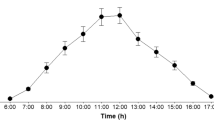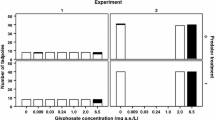Abstract
Commercial formulations of pesticides contain both active and other ingredients. In some instances, the other ingredients have detrimental effects on nontarget species. Other factors such as UV radiation and predator cues have been shown to modify the toxicity of pesticides. In a laboratory study we compared the effects of technical-grade active ingredients to commercial formulations of seven common pesticides in the presence or absence of UV radiation on the survival of Rana clamitans (green frog) tadpoles over 96 h. We found a significant difference in the survival of tadpoles in technical-grade active ingredients versus commercial formulations in all of the pesticides tested. We also found that either the presence or the absence of UV radiation affected the survival of tadpoles in five of the seven pesticides tested. These results suggest that there is a need to test the effects of both active ingredients and commercial formulations of pesticides and, also, to include relevant abiotic factors like UV radiation treatments in the testing of pesticides because they can have a dramatic impact on the toxicity of some chemicals.







Similar content being viewed by others
References
Boone MD (2008) Examining the single and interactive effects of three insecticides on amphibian metamorphosis. Environ Toxicol Chem 27:1561–1568
Boone MD, Bridges CM (1999) The effect of temperature on the potency of carbaryl for survival of tadpoles of the green frog (Rana clamitans). Environ Toxicol Chem 18:1482–1484
Bridges CM (1999) The effects of a chemical stressor on amphibian larvae: Individual, population, and species level responses. Ph.D. dissertation. University of Missouri, Columbia
Bridges CM, Boone MD (2003) The interactive effects of UV-B and insecticide exposure on tadpole survival, growth and development. Biol Conserv 113:49–54
Bridges CM, Dwyer FJ, Hardesty DK, Whites DW (2002) Comparative contaminant toxicity: are amphibian larvae more sensitive than fish? Bull Environ Contam Toxicol 69:562–569
Davidson C (2004) Declining downwind: amphibian population declines in California and historical pesticide use. Ecol Appl 14:1892–1902
Davidson C, Shafer HB, Jennings MR (2001) Declines of the California red-legged frog: climate, UV-B, habitat, and pesticides hypotheses. Ecol Appl 11:464–479
Davidson C, Shafer HB, Jennings MR (2002) Spatial tests of the pesticide drift, habitat destruction, UV-B, and climate-change hypotheses for California amphibian declines. Conserv Biol 16:1588–1601
Drenner RW, Hoagland KD, Smith JD, Barcellona WJ, Johnson PC, Palmieri MA, Hobson JF (1993) Effects of sediment-bound bifenthrin on gizzard-shad and plankton in experimental tank mesocosms. Environ Toxicol Chem 12:1297–1306
Edginton AN, Sheridan PM, Stephenson GR, Thompson DG, Boermans HJ (2004) Comparative effects of pH and Vision herbicide on two life stages of four anuran amphibian species. Environ Toxicol Chem 23:815–822
Feng S, Kong Z, Wang X, Zhao L, Peng P (2004) Acute toxicity and genotoxicity of two novel pesticides on amphibian, Rana N. Hallowell. Chemosphere 56:457–463
Gosner N (1960) A simplified table for staging anuran embryos and larvae with notes on identification. Herpetologica 16:183–190
Gupta S, Gajbhiye VT (2005) Dissipation of B-cyfluthrin in water as affected by sediment, pH, and temperature. Bull Environ Contam Toxicol 74:40–47
Heath SW, Bennet A, Kennedy J, Beitinger TL (1994) Heat and cold tolerance of the fat head minnow, Pimephales promelas, exposed to the synthetic pyrethroid cyfluthrin. Can J Fish Aquat Sci 51:437–440
Howe CM, Berrill M, Pauli BD, Helbing CC, Werry K, Veldhoen N (2004) Toxicity of glyphosate-based pesticides to four North American frog species. Environ Toxicol Chem 23:1928–1938
Kiely T, Donaldson D, Grube A (2004) Pesticide industry sales and usage: 2000 and 2001 market estimates. U.S. Environmental Protection Agency, Washington, DC
Kitulagodage M, Astheimer LB, Buttemer WA (2008) Diacetone alcohol, a dispersal solvent, contributes to acute toxicity of a fipronil-based insecticide in a passerine bird. Ecotoxicol Environ Saf 71:597–600
Laskowski DA (2002) Physical and chemical properties of pyrethroids. Rev Environ Contam Toxicol 62:448–454
Lund-Høie K, Friestad HO (1986) Photodegradation of the herbicide glyphosate in water. Bull Environ Contam Toxicol 36:723–729
Mann RM, Bidwell JR (1999) The toxicity of glyphosate and several glyphosate formulations to four species of southwestern Australian frogs. Arch Environ Contam Toxicol 36:193–199
Morris DP, Zagarese H, Williamson CE, Balseiro EG, Hargreaves BR, Modenuuti B, Moeller R, Queimallinos C (1995) The attenuation of solar UV radiation in lakes and the role of dissolved organic carbon. Limnol Oceanogr 40:1381–1391
Pereira JL, Antunes SC, Castro BB, Marques CR, Gonçlaves AMM, Gonçlaves F, Pereira R (2009) Toxicity evaluation of three pesticides on non-target aquatic and soil organisms: commercial formulation versus active ingredient. Ecotoxicology 18:455–463
Pierce RH, Henry MS, Blum TC, Mueller EM (2005) Aerial and tidal transport of mosquito control pesticides into the Florida Keys National Marine Sanctuary. Revista Biol Trop 53:117–125
Rawn GP, Webster GRB, Muir DCG (1982) Fate of permethrin in model outdoor ponds. J Environ Sci Health Part B 17:463–486
Relyea RA (2003) Predator cues and pesticides: a double dose of danger for amphibians. Ecol Appl 13:1515–1521
Relyea RA (2004) Syneristic impacts of malathion and predatory stress on six species of North American tadpoles. Environ Toxicol Chem 23:1080–1084
Relyea RA (2005) The lethal impacts of Roundup and predatory stress on six species of North American tadpoles. Arch Environ Contam Toxicol 48:351–357
Relyea RA, Diecks N (2008) An unforeseen chain of events: lethal effects of a pesticides on frogs at sublethal concentrations. Ecol Appl 18:1728–1742
Relyea RA, Mills N (2001) Predator-induced stress makes the pesticide carbaryl more deadly to gray treefrog tadpoles (Hyla versicolor). Proc Natl Acad Sci USA 98:2491–2496
Sayim F (2008) Acute toxic effects of malathion on the 21st stage larvae of the marsh frog. Turk J Zool 32:99–106
SERA (2005) Imidacloprid–human health and ecological risk assessment. SERA TR 05-43-24-03a. Final Report. Prepared for USDA, Forest Service, Washington, DC
Stacell M, Huffman DG (1994) Oxytetracycline-induced photosensitivity of channel catfish. Progr Fish Cultur 56:211–213
Tietge JE, Diamond SA, Ankley GT, DeFoe DL, Holcombe GW, Jensen KM, Degitz SJ, Elonen GE, Hammer E (2001) Ambient solar UV radiation causes mortality in larvae of three species of Rana under controlled exposure conditions. Photochem Photobiol 74:261–268
Tilak KS, Rao DM, Devi AP, Murty AS (1981) Toxicity of carbaryl and 1-naphthol to four species of freshwater fish. J Biosci 3:457–461
Waller DL, Rach JJ, Cope WG, Marking LL, Fisher SW, Dabrowskov H (1993) Toxicity of candidate molluscicides to zebra mussels (Dreissena polymorpha) and selected nontarget organisms. J Great Lakes Res 19:695–702
Wamhoff H, Schneider V (1999) Photodegradation of imidacloprid. J Agric Food Chem 47:1730–1734
Wojtaszek BF, Staznik B, Chartrand DT, Stephenson GR, Thompson DG (2004) Effects of Vision herbicide on mortality, avoidance response, and growth of amphibian larvae in two forest wetlands. Environ Toxicol Chem 23:832–842
Zaga A, Little EE, Rabeni CF, Ellersieck MR (1998) Photoenhanced toxicity of a carbamate insecticide to early life stage anuran amphibians. Environ Toxicol Chem 17:2543–2553
Acknowledgments
We thank M. Mackey, M. Davis, and R. Krankowski for assistance in the laboratory. This research was supported by Miami University’s Undergraduate Summer Scholars (H.J.P.) and the NSF (Grant DEB 0717088 to M.D.B.).
Author information
Authors and Affiliations
Corresponding author
Rights and permissions
About this article
Cite this article
Puglis, H.J., Boone, M.D. Effects of Technical-Grade Active Ingredient vs. Commercial Formulation of Seven Pesticides in the Presence or Absence of UV Radiation on Survival of Green Frog Tadpoles. Arch Environ Contam Toxicol 60, 145–155 (2011). https://doi.org/10.1007/s00244-010-9528-z
Received:
Accepted:
Published:
Issue Date:
DOI: https://doi.org/10.1007/s00244-010-9528-z




